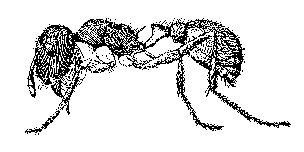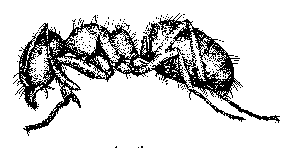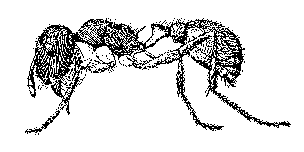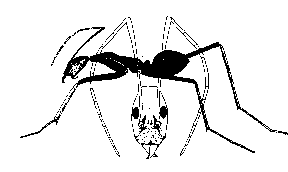Interaction, Networks and
Colony Behavior
Deborah M. Gordon
(Princeton)

It used to be assumed that the queen was in charge, but now it is known that the queen has little to do with the proper functioning of the nest except as population provider. She is an egg-lay machine: you need babies, she supplies babies, by the gross. Gordon writes,
- The basic mystery about ant colonies is that there is no management ... There is no central control. No insect issues commands to another or instructs it to do things in a certain way. No individual is aware of what must be done to complete any colony task.
In our previous review, we wrote, "Gordon is a worthy researcher, and, more importantly for us, a good --- and often funny --- writer." And we find in her latest book, Ant Encounters, that, once again, she knows ants, knows how to explain them so we can understand them. She certainly does her homework. For instance, at the end of this, her latest book, she offers some 150 references, from the famous (Edmund O. Wilson, The Ants), to the obscure (A. S. Mikheyev, author of "Cryptic sex and many-to-one coevolution in the fungus-growing ant symbosis.")
There are evidently some 11,000 known species of ants, but "only fifty have been studied in detail." She's one of those antologists (I just made up that word) who contributes with wit and precision to our knowledge of these creatures. How do they work? How do they get it all together to create a nest, to occupy it, to defend it if necessary --- and to create a brood without the benefit of a director-general?
The joke is that Gordon doesn't seem to be all that fond of her subjects. For one thing, she tells us that they aren't very smart. "When you watch real ants, they don't look like they do on TV. You see a lot of bumbling around, a few ants going the wrong way, ants pulling an object in different directions."
- You have to watch more than one ant to learn anything about their behavior, because of every five ants that embark on a task, three will never manage to do it before you get distracted or lose sight of them. The other two might turn out to be doing something you never thought of.

All the while, she tells us, "the ants rained down my neck from the vegetation above. I learned to look up." She says that study there is a bit more complicated, if not dangerous. "It's hard to stand under a tree full of stinging ants and calmly contemplate their comings and goings."
The interest for this reader is the way we have tried to deal with ants over the years (it's called "pest control.") It was thought that we could manage the huge infestation of fire ants, and between 1957 and 1982, "millions of acres throughout the southeast United States were sprayed from the air with extremely potent pesticides, including dieldrin, heptachlor, and mirex." These may have been toxic for the ants, but they were also poison to small mammals, birds and probably humans (the use of these pesticides is now banned in this country.)
Fire ants had been kept in check by other ant species, but after the twenty-five years of spraying, the only ones to survive and repopulate quickly were --- you guessed it --- fire ants. Fire ants have even been able to move in force into California because another invasive species, the Argentine ant, has cleared the way for them.
And Argentine ants are taking over the world. Back when I lived in California, if I left my lunch out too long, I would go back in the kitchen and find about a million of the pesky bastards all over my plate, the counter, the sink, the walls.
And, warns Gordon, don't think you can best them, for we have made it possible for them to prosper. We carry them to new places where they can set up "supercolonies." Our homes and other buildings are excellent places for them to hang out. In warm weather, they set up many "distinct nests connected by trails." These nests come complete with their own queens and workers. When it gets cold and rainy, our houses become ant hotels. There's food and water and heat and lots of hiding places. "Because we provide a refuge, Argentine ant populations are larger in developed areas."

- They transform soil everywhere, aerating it with their tunnels and enriching it with the nurrients they collect and adsorb.
According to Gordon, ants can and do apper to be red and black, but there are also "yellow, green, and even blue ants, as well as orange, gray and brown ones."
- They range in size from the little fire ant Wasmannia aurapunctata, barely 2 millimeters long, to the intimidating bola ants in the genus Panaponera, some more than 3 centimeters long, common in tropical forests.
I don't know about the bola, but I have too much experience with those little teeny bastards (although they have yet to sting me). Since I left California, I live much of the time near the equator. I wouldn't exactly call this area tropical rain forest, but we have ants out the gazoo. The ones that irritate me the most are about the size of a pin-head, and they are pin-heads in general.
For some reason, they are enamored of my computer keyboard, have decided to call it home, and pop in and out regularly when I am working. They zip around in sort of a blur, are so fast I can barely keep up with them. They manage not only to infest my computer, but regularly to fall on me, falling from god knows where on my head, shoulders, ears, arms and hands.
They are most irritating when I am trying to read, as happened today when I was finishing off Ant Encounters. Did the little creeps somehow know I was studying their ancestry? One zipped across the page and started up my arm. As soon as I got rid of him, his brother or sister or cousin popped up on my chest, heading downriver, and I had to get the bugger out of the way before I could continue. I was tempted to call up Gordon and ask if these creeps are attracted to her too --- and to others, like her, who are intent on studying them.

As I was digesting this whopper, a long roseate ant fell from the almond tree onto the page I was reading. It was as weird a creature as I've ever seen: long and skinny, the size of a pencil lead, maybe half-an-inch long, ruby-colored, completely tranparent.
As it wandered around about from word to word on its book, I found I could treasure this rosy beast ... as it wandered, so leisurely, across the very words that were telling me how lovely its ways, and its world.
Ants at Work
can be found in the collection
The Noisiest Book Review
in the Known World
Volume II, Page 403